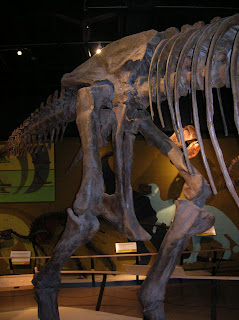Blog Entry 4: Lab Notes (
Location: Cleveland Museum of Natural History
Time:
Objective: To observe the diversity of Dinosauria.

Background:
With over 1000 species of dinosaurs and over 500 genera, Dinosauria comprised a large part of Reptilian diversity. Rooted within Archosauromorpha, they had a very distinct morphology, having 4 basic characteristics: 1.) supracetabular crest; 2.) antorbital fenestrae; 3.) enlarged fourth trochanter; 4.) digitigrade stance (tip-toe stance). In general, within Dinosauria, there are two distinct clades: Saurischia and Ornithischia. There are many features that distinct the Saurischian dinosaurs (Lizard-like dinosaurs) from the Ornithischian dinosaurs (Bird-like dinosaurs).
Main characteristic that distinguishes Saurischian dinosaurs:
- Presence of 3 pronged pelvic girdle with pubis projecting anteriorly and ventrally
Main characteristics that distinguish Ornithischian dinosaurs:
- Reduced antorbital fenestra
- Ventral margin of the antorbital fenestra that parallels the maxillary tooth row
- Pubis typically directed posteriorly
Lab:
Step 1: We began the lab by first observing a Baby Tyrannosaurus rex skeleton (or what some may consider Nanotyranus). This was obviously a Saurischian dinosaur, due to the apparent 3-pronged pelvic girdle and anteriorly/ventrally projecting pubis.

Step 2: Next we entered the Hall of Prehistoric Life, where most of the dinosaurs were on display. The main display (seen below) was a beautiful scene with classic examples of Saurischian (Tyrannosaurus rex) and Ornithischian (Triceratops horridis) dinosaurs. While there are a number of synapomorphies for both the Saurischian and Ornitithischian dinosaurs, by looking at the main characterstics (listed above in the blog) we were able to identify which species represented the appropriate clade.




Step 5: Next we observed skulls of Corythosaurus (bottom left), Parasaurolophus (right), and Edmontosaurus (top left). All have clear diapsid fenestration, but no antorbital fenestrae.


Step 7: The limbs and girdles of Tyrannosaurus rex are very prominent Saurischian type (picture below)

Step 8: In comparing the pelvic girdles and skeletons of both Haplocanthus delfsi (below right) and Allosaurus fragilis (bottom left), there is a relatively large difference in terms of skeletal arrangement. The pelvic girdles however are very similar, both showing the Saurischian condition.




Ichthyosaurus



Step 12: The last specimen we observed was of an extant group of organism in the clade Sphenodontida, (photo below of Sphenodon punctatus). This nearly extinct lineage is localized to islands off the coast of



No comments:
Post a Comment